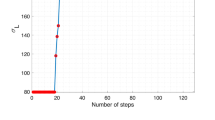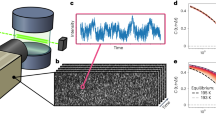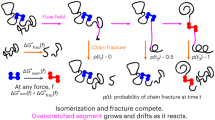Abstract
IN order to evaluate the individual velocity coefficients for the propagation and termination reactions involved in polymerization and other chain processes, it is necessary to measure the lifetime of the kinetic chain. This is usually done by means of the rotating-sector method1, or one of the non-stationary state methods2–6. The main disadvantage of the former method is that the complete determination of a kinetic chain lifetime cannot normally be made with a single filling of a dilatometer, unless the reaction is taken beyond the initial stage which may lead to gel effects and other complications. A number of dilatometers are therefore usually employed in a single determination of a lifetime, and errors often occur due to difficulty in reproducing the exact conditions, especially when the monomer involved is difficult to purify. The non-stationary state methods, on the other hand, yield a value for the lifetime in ≤30 sec.; but unfortunately they often are inaccurate when lifetimes of ≤0.5 sec. occur, since instrument lags or personal response times become particularly important for the very short lifetimes. The actual rate measurements, however, are quite accurate in this range of lifetimes, and can be measured in about 10 sec., that is, when 0.01 per cent reaction has occurred. By combining the two methods it is possible to cope with lifetimes of ±0.5 sec., and to carry out a complete determination of a lifetime of the kinetic chain before 1 per cent reaction has occurred. The method is not valid for lifetimes ≫0.5 sec., since when flashtimes of several seconds are used the measurement of the rate by non-stationary state methods becomes inaccurate.
This is a preview of subscription content, access via your institution
Access options
Subscribe to this journal
Receive 51 print issues and online access
$199.00 per year
only $3.90 per issue
Buy this article
- Purchase on Springer Link
- Instant access to full article PDF
Prices may be subject to local taxes which are calculated during checkout
Similar content being viewed by others
References
Burnett and Melville, Proc. Roy. Soc., A, 189, 456 (1947).
Majury and Melville, Proc. Roy. Soc., A, 205, 496 (1951).
Grassie and Melville, Proc. Roy. Soc., A, 207, 285 (1951).
Bengough and Melville, Proc. Roy. Soc., A, 225, 330 (1954).
Miyana, Bull. Chem. Soc. Japan, 29, 711 (1956).
Bengough, Trans. Farad. Soc., 54, 868 (1958).
Author information
Authors and Affiliations
Rights and permissions
About this article
Cite this article
BENGOUGH, W., McINTOSH, S. & THOMSON, R. A Modified Rotating-Sector Method of Measuring Kinetic Chain Lifetimes. Nature 184, 266–267 (1959). https://doi.org/10.1038/184266a0
Issue Date:
DOI: https://doi.org/10.1038/184266a0
Comments
By submitting a comment you agree to abide by our Terms and Community Guidelines. If you find something abusive or that does not comply with our terms or guidelines please flag it as inappropriate.



